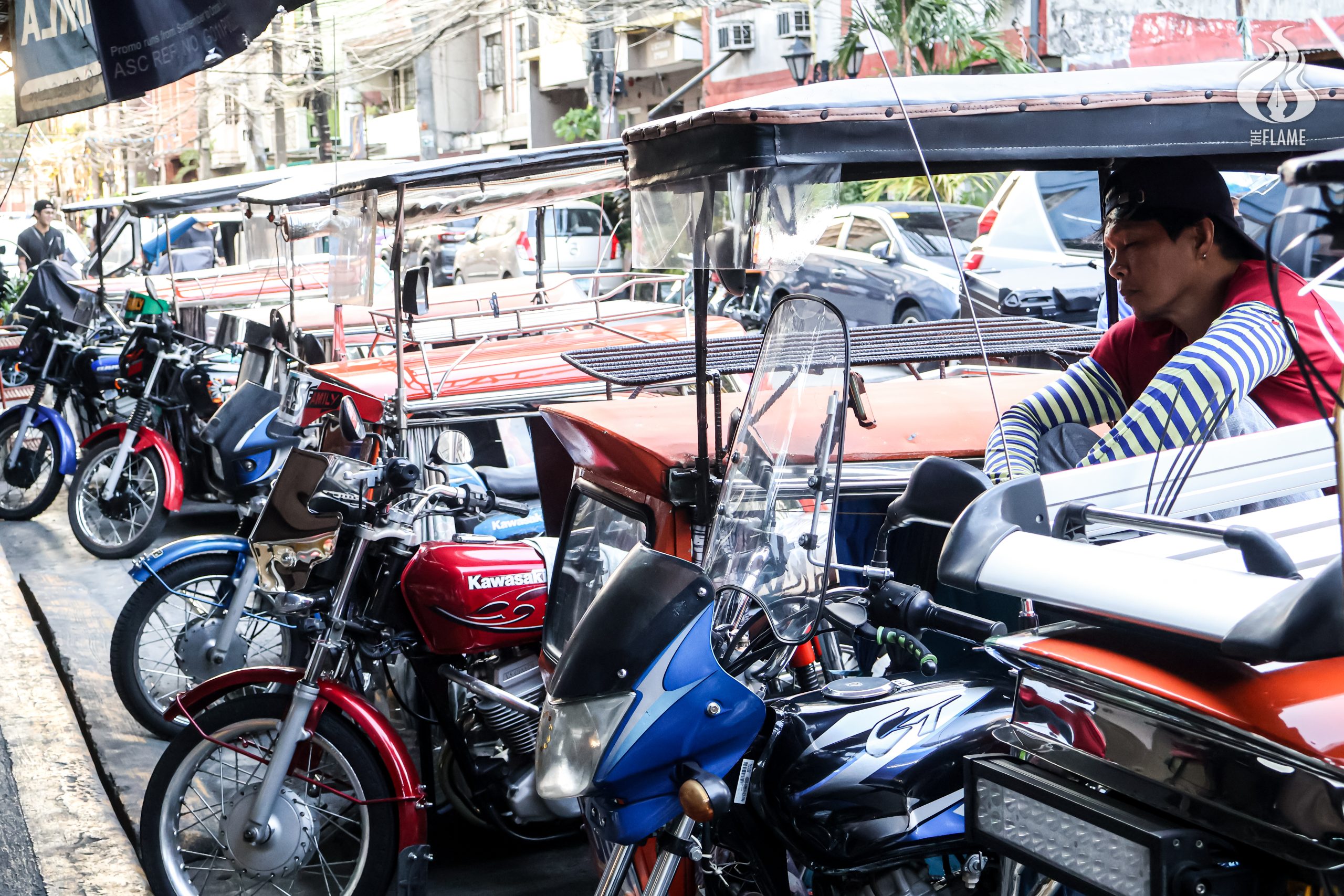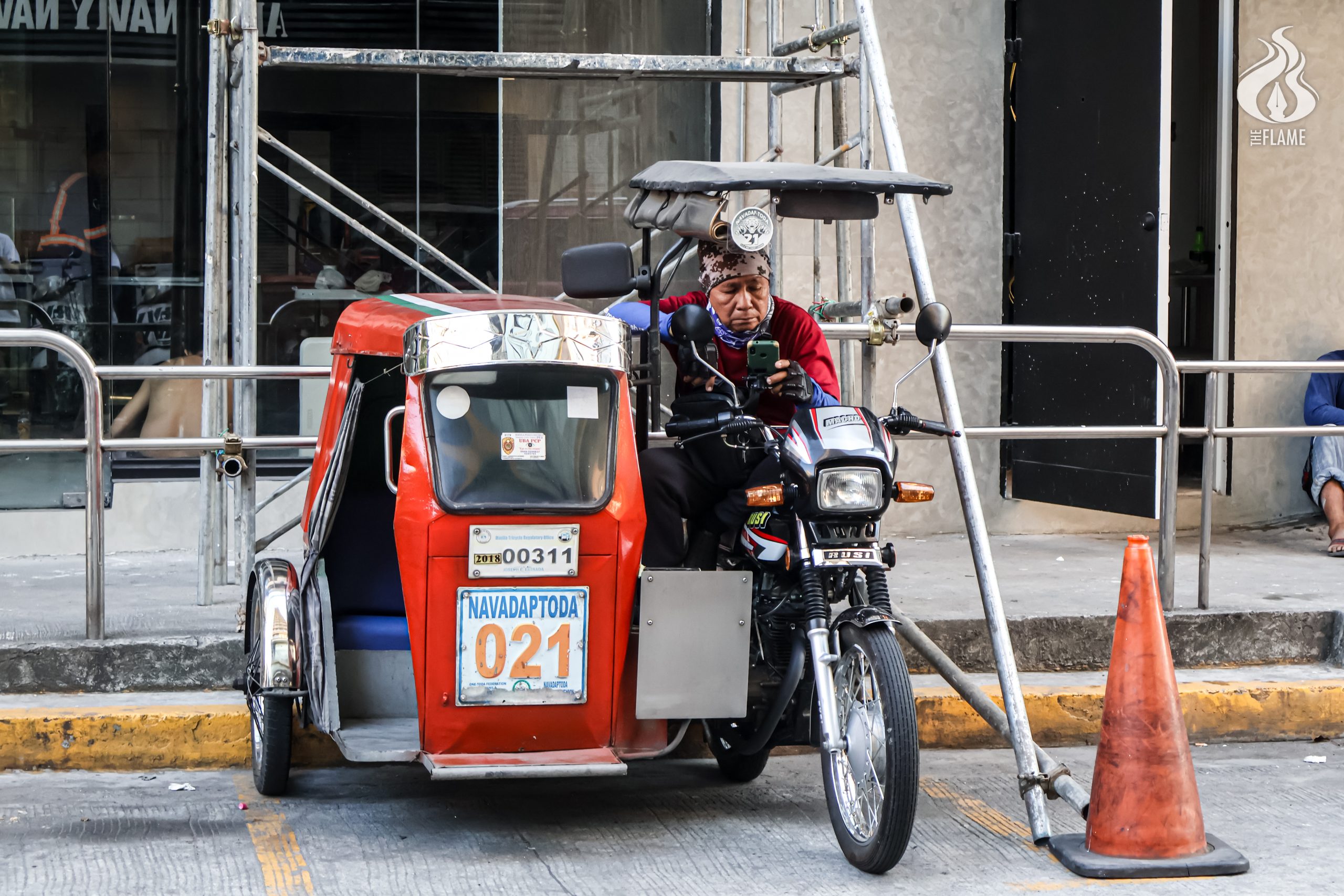
AS HE reached the exit of the Manila Light Rail Transit (LRT) Legarda station, economics freshman Angelo Nodalo encountered the familiar sight of tricycle drivers demanding P30 for a solo ride.
The price, P9 higher than the standardized fare introduced in September 2023, reflected the ongoing challenge of implementing the new fare matrix.
Manila introduced its first standardized fare matrix for tricycles and other tri-wheel vehicles last year to address passenger complaints of overpriced fares. This move came after years of regulated fares for other public utility vehicles like buses and jeepneys.
Nodalo, however, remained unaffected by the matrix and is accustomed to paying the pre-existing rate. “Nothing much has changed,” Nodalo said.
“I pay the amount I’ve paid ever since I learned how much the prices are.”
Under the new system, the 900-meter journey from Legarda station to UST via Earnshaw and Cayco streets should cost P16 or P13 for sectors entitled to a discount, including students.
However, three months after its release, the matrix faces resistance from drivers struggling to adapt to the fixed rates, especially in the face of rising fuel prices.“Right now, it’s tough,” Rueben (not his real name), an España-based tricycle driver, said.
“It feels like we’re losing money, especially with gasoline prices continually rising and not going down.”
Understanding the tri-wheel fare matrix
The Manila Traffic and Parking Bureau’s Tri-Wheel Management Unit (MTPB-TMU) led the creation of a standardized fare matrix as a response to numerous complaints of overpricing on tricycle rides, according to Eduardo Pablo, the unit’s chief operations.
Ordinance 8979, signed by Manila Mayor Honey Lacuna on Sept. 18, 2023, applies to tricycles, pedicabs and even electric tricycles (e-trikes). Passengers are charged a base fare depending on the vehicle type: P16 for tricycles and pedicabs and P20 for e-trikes within their designated routes.
For trips exceeding the first kilometer, an additional P5 is charged every 500 meters for tricycles and pedicabs. Students, persons with disabilities, and senior citizens enjoy a 20% discount as mandated by existing laws, namely, Student Fare Discount Act, Republic Act 10754 and Expanded Senior Citizens Act of 2010.
The matrix, however, applies primarily to standard rides. Negotiated “special trips” may cost different fares, with solo passengers sometimes covering the equivalent of four passengers.
“It’s P16 per passenger, times four, making the fare P64 (for special trips),” Pablo told The Flame.
According to Pablo, the drafting of the ordinance began during the administration of former mayor Isko Moreno Domagoso. The former mayor had set a P20 base tricycle fare with an additional P5 for every 500 meters in 2020, which was also the first price drafted for the matrix.
One size doesn’t fit all
Some tricycle drivers argue that the fare matrix, while offering predictability for standard rides, is impractical for some situations.
Because there are variations within the tricycle operators’ and drivers’ associations (TODAs), Padre Noval TODA (PANTODA) president Billy Macasio, Sr. said the matrix does not reflect his members’ usual pricing for special trips.
“The fare matrix doesn’t apply to special trips, which is what we mostly do. We can follow it if the tricycle is full, with four or five people paying P16 each. But our minimum charge remains P50, even if we have multiple passengers,” Macasio told The Flame.
Unlike areas near LRT stations with consistent passenger flow, tricycle drivers in other locations struggle to find return fares, such as Boy Lorica, who operates on routes from Dapitan Street.
“Near LRT stations, passengers disembark simultaneously and often head towards the same destination, like UST,” Lorica said.
“Here, it’s different.”
The 900-meter trip from LRT 2 – Legarda Station to UST’s Blessed Pier Giorgio Frassati Building on España Boulevard exemplifies this. Under the matrix, it would cost a fixed P16, an amount some drivers find insufficient, especially on return trips.
“After taking passengers to SM San Lazaro, we often have no passengers on the way back,” PANTODA driver Leonardo Reyes told The Flame.
“Using the matrix for that return trip would only earn us P16, barely covering fuel costs…We can’t wait for passengers – nobody will ride if we do. By noon, we might still be here.” he added.
The fare system highlighted another challenge in measuring distances in congested traffic.
“We can’t base fares solely on kilometers because measuring them precisely is impossible,” Mike (not his real name), a MIDESTODA (Sampaloc) driver, said.
MIDESTODA plies its routes in Sampaloc from beside UST’s Frassati Building.
“For trips to SM San Lazaro, for instance, we often ask passengers, ‘Ma’am, how much do you usually pay for this ride?’” Mike added.
According to Pablo, route maps for the city’s more than 200 TODAs primarily cover one-kilometer distances. Even though drivers can drop off passengers outside their designated areas, they must return empty-handed, as picking up passengers on the return trip constitutes going “out of route.”
“It’s their (tricycle drivers) call [whether to go beyond their route maps]. But once we catch them traveling such distances, they’re already out of route,” Pablo said.
“Often, we catch them as they’re also being reported by drivers from the district [they’re not supposed to be in],” he added.
‘Unfair’ fares sparks anger
Since Ordinance 8979’s implementation in October 2023, TMU-MTPB recorded a decrease in reported complaints of overcharging and missing fare matrices.
“Last March and this April, there were only a few who complained… A complaint in a day now seldom happens, unlike when we first started on Oct. 25 last year,” Pablo said.
“During our first special operations at around Oct. 25, we received reported cases perhaps 50% of the time, which also decreased during the months of January and February. Until now, the complaints continue to decrease to at least 5% or less.”
However, commuters like Angela Mitra continue to grapple with the inconsistency of tricycle fares. The journalism student’s daily tricycle ride from LRT 1 – Bambang station to either Dapitan or Padre Noval Street should cost P21 under the standardized fare – given the 1.5-kilometer distance. Yet, she had encountered drivers charging a P60 “special trip” fare, even offering inconsistent prices on different days. This has left her wary of riding tricycles in general.
“The driver said the fare was only P50 from Bambang to Noval [Street]. The next day, I only paid P50 [to a different driver] when I was dropped off at Noval, but the driver insisted the fare was really P60,” Mitra said.
“There was also a time I was charged P100 by a tricycle driver when I got off the other side of the road… I am not really familiar with the place, but I am sure it was only within Bambang,” she added.
Now, Mitra prioritizes confirming fares upfront and seeking alternative modes of transport to avoid surprises.
Other commuters, like Nodalo, have adapted to the tricycle drivers’ behavior. He avoids “special trips” by paying the exact P30 fare and choosing to walk rather than pay higher charges, especially at night.
“As much as possible, I want to avoid that (special trips) because I want to [save up for my other daily expenses],” Nodalo explained.
Even though Nodalo understands the drivers’ need to make a living, he considered the P10-P15 fare increases to be unreasonable.
For Pablo, there is a reason behind some seemingly inflated fares.
“If they’re two [passengers], they will also pay for the remaining fares of two other people since it’s a special trip and they already want to start the trip [without waiting for the tricycle to be fully occupied],” Pablo said.
Unreported issues
Every problem starts with evidence of the issue. For the MTPB-TMU operations chief, the evidence must be a complaint.
“As long as there is no complaint, there is no problem,” Pablo said.
The unit conducts special operations to investigate cases, in which the officials talk with the reported driver, assess the situation and provide feedback to the complainant based on their findings. The unit relies on commuter reports to conduct targeted investigations. With over 200 TODAs in the city, Pablo admitted that monitoring every tricycle for fare violations is a near-impossible task.
Common complaints received by the MTPB-TMU include driver arrogance, overcharging and the absence of posted fare matrices.
“We don’t pick sides on such issues,” Pablo said.
“It’s alright if a passenger paid lower than the matrix… If the passenger [still] complained, we will defend (the tricycle drivers) and we will explain (the proper charges) to the complainant.”
Pablo explained the concept of a “contract” between drivers and passengers. If they agree on a fare outside the matrix, it’s considered valid as long as there is no overcharging.
“It’s really a contract. Now, if they had no agreement and the passenger was overcharged [according to the matrix], it is a case of overcharging,” he added.
However, exceeding the designated route is strictly prohibited, under the Manila Tri-wheel Vehicle Ordinance of 2012.
This leaves passengers vulnerable to overcharging since the distance traveled becomes unclear, Pablo said.
“Even if the driver charges more than the matrix since they’re out of route,” Pablo said.
“It becomes an agreement between them and the passenger.”
This explained Mitra’s decision not to report her experience.
“I’d also rather not argue with [tricycle] drivers since I have no one with me,” she said.
Beyond fare compliance, the MTPB-TMU verifies if tricycles display the fare matrix, possess permits from local government units, and have valid driver’s licenses and vehicle registrations – all of them mandatory requirements.
Ordinance 8979 of Manila outlined several offenses, including overloading, overcharging, and “contracting out services,” or allowing someone else to operate the tricycle for public transport. Fines of P1,000, vehicle impoundment, and even cancellation of permits can result from violations, depending on the severity and frequency of the offense.
According to Pablo, the Land Transportation Office (LTO) is discussing registrations for e-tricycles, while the Metropolitan Manila Development Authority (MMDA) is enforcing a ban on e-tricycles on major roads starting April 15 this year. Three days after the start of the implementation of the ban, President Ferdinand Marcos, Jr. suspended the imposition of penalties to give drivers more time to be familiar with the policy.

Are costs outpacing drivers’ profit?
A P16 base fare might seem sufficient initially, but economist Danielle Mellesse Canto told The Flame it is only a short-term solution for a government that is not the source of transportation.
“In the short run, the P16 base fare is enough. This can be a temporary solution,” Canto said.
“But in the long run, several factors must be considered in order to adjust the base fare for the sake of both commuters and drivers,” she added.
Canto noted that the fare matrix may not guarantee a driver’s livelihood in the Philippines. Since transportation relies heavily on individual ownership, fares often function as negotiated agreements, not a rigid matrix system.
“This is where the government intervenes. If not, it would bring a huge impact on both micro and macro levels in the economy,” Canto said.
UST economics Asst. Prof. Ederliza Magpantay explained that inconsistent fares can lead to unequal income distribution among tricycle drivers.
“They will see a shortage of supply in tricycles in one area for sure [due to lower than the matrix fare charges],” Magpantay told The Flame.
Fuel prices in the country continue to increase as inflation in the country rose to 3.7% in March from 3.4% in February.
According to the Department of Energy, there was a rollback of prices per liter on fuel last Apr. 2, 2024: diesel by P0.60 and kerosene by P1.05. However, gasoline prices increased by P0.45 per liter.
However, all fuel prices were expected to rose by about P1 across all products the following week.
According to drivers interviewed by The Flame, monthly fuel costs can reach up to P2,500, but it is just one expense drivers face. They must also cover regular maintenance, including oil changes and tire upkeep, costing around P800 monthly.
On top of that, Manila City Ordinance 8291 mandates clean windshields, garbage bins, functional lights and horns and proper registration for tricycles, which are also inspected by the MTPB-TMU for the release of a franchise and motorized tricycle operator’s permit. Non-compliance may lead to license suspension or franchise revocation.
According to the Land Transportation Management System (LTMS) online portal, vehicle registration itself costs P1,729, encompassing renewal fees, insurance, emission testing and stencils. Smoke emission testing adds another P500 to the operational costs.
Despite these expenses, Magpantay acknowledged that drivers’ control over their work hours allows them some flexibility to manage rising fuel costs.
“[But] there will always be someone willing to enter the sector due to it being a flexible job where the person holds their time,” she added.
Calls for adjustment, fairness
Some drivers interviewed by The Flame expressed hope that there would be adjustments to the fare matrix, particularly for “special trips,” to better reflect their expenses.
“The matrix doesn’t account for our expenses. Many of us have families to support and are already in debt,” a tricycle driver who opted for anonymity said.
Some drivers also yearn to return to the previous system under Domagoso, where fares were fixed at P20 per passenger, regardless of the number of riders.
This, they believe, would create a fairer system, especially for trips with less than a full load.
“They should fix that (matrix) because before, under Mayor Isko, it was only P20 each… because each person only pays P20… It should be like that, so if there are only three passengers, it should be fixed at P20 each for fairness,” the anonymous driver said.
Tricycle drivers also call for a comprehensive fare review that considers costs, road access and passenger capacity, especially compared to the emerging e-tricycle market.
“We’re not like jeepneys that pick up passengers wherever. We go straight from one end to the other,” Rueben (not his real name) said.
But there are instances when a tricycle driver’s problem is more than about the limits of an assigned route.
“If students don’t have classes, we don’t make any money,” another driver who requested anonymity said. F



